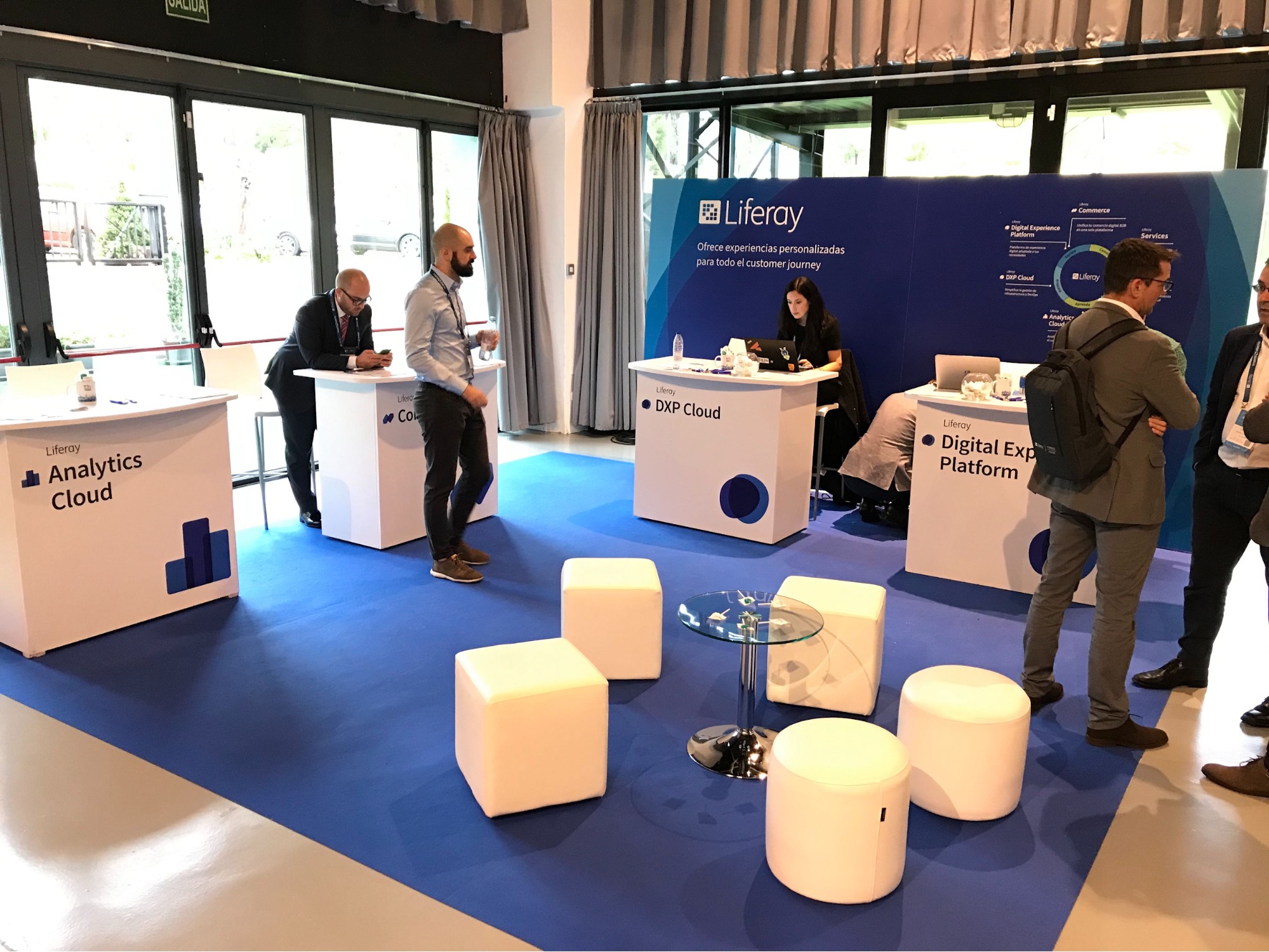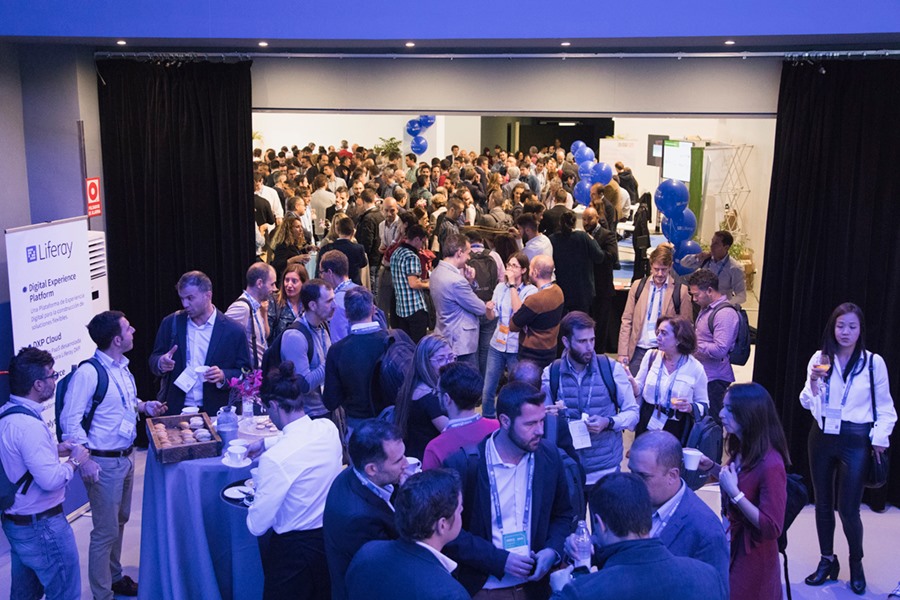6 Things We Learned about Designing for a Conference by Marleny Francisco and Rachel Yuan on November 20, 2019
4 Min Read

Designing for a large-scale event is always a challenge. With so many moving parts, it is important to focus on a clear goal in order to keep yourself and the team organized. Working on the recent Liferay Symposium Spain was an amazing experience. We had the opportunity to closely collaborate with teams from different countries and work with various media outlets and providers.
Based on this experience, we compiled six tips to share our story and help you better understand how to design for a big event or multifaceted project.
1. Inform your designs
A vital first step is to gather all the information about the event. Get the “big picture” by asking questions, such as:

- What are the main objectives and goals?
- Who is the target audience?
- Which departments are involved? What are their roles and business requirements?
- What is the analysis of previous events?
- What is the event's "personality"?
- Where is design needed?
Gathering these details gave us useful insight into the expectations for this event, which informed our decision making, problem-solving, and designing of different assets.
It is also helpful to sit in on any planning meetings even if they are not directly related to design tasks. Not only does this give you a comprehensive overview of budding plans, but also opportunities to offer creative solutions to the marketing team.
2. Manage time effectively
Like any good time management rule, have a weekly plan and set daily goals. Creating a list of tasks can help you visualize a timeline and prioritize tasks. This list also can help monitor progress and keep you motivated. It’s also a good idea to plot all tasks with their production times and deadlines onto a master calendar or spreadsheet, so there is a visual that can be easily understood by anyone it’s shared with. Consider due dates and the assets’ mediums, especially taking into account vendors’ estimated turnover time for printed materials (i.e. photo backdrop, booths, awards, or merchandising).
When new requests and deadlines are being made, this is particularly handy to reference. All parties involved can clearly see which weeks are more or less impacted, and what items would need to be moved around in order to fit any new requests in.

3. Identify what can be improved
There's always something that can be done better. Sometimes we can become too passive while working within a series of designs and fall into the trap of being uninspired and repetitive. It’s necessary to ask ourselves, “How can this be better?”
Keep a running list (yes, another list!) of things that can be improved, both in design and process. If the resources needed to address a long list of improvements are scarce, pick one or two things that would have the greatest impact, and focus your precious time on those. In reality, this list will continually have new items added to it, but identifying and prioritizing the to-dos will keep the improvement process going. Anything on the list that doesn’t get resolved can be included in the preparation for the next event.
Small Changes Can Create Big Results
A small change that made a big difference at the Symposium this year was reflected in efforts to attract attendees to use and interact with our photocall (aka “photobooth” for our non-Spanish amigos). Over the years our photocalls started to fade into the background and attendees were no longer excited to take their selfies with them.

It needed to be in front of the cameras again this year at Symposium. It’s a natural opportunity for social media sharing and event hashtag use by attendees, and we didn’t want to let it slip by another year. We created a cutout of the Liferay Symposium Anniversary logo that attendees could pick up and pose with. This quick, simple, and inexpensive change created the desired impact and increased the attendees’ excitement around our photocall.
4. Communicate, communicate, and then communicate some more
Whether it’s with your fellow designers, marketing folks, event planners, or vendors, always follow up with all teams you work with. Do not assume. It’s likely they are juggling just as many tasks as you are, and things can get dropped. A continuous flow of conversation throughout the process can quickly bring to attention and clear up any misunderstandings before they get too far along. This can be accomplished by setting recurring check-ins and keeping documentation on plans and tasks open to the entire event collaboration team.
5. Stay vigilant at the venue
The day has come and you're almost there! It’s really exciting to see all your hard work come together.
When finally on-site, all your attention is on setting up and supervising the assembly. Keep your eyes on the details to ensure that everything is as you designed. Often times, labor laws are such that you are not allowed to physically set up anything yourself. It’s up to the vendors or contracted laborers to take care of it. Their jobs may be to set it up, but your job is to make sure it’s set up correctly. Don’t be afraid to ask for things to be adjusted or moved over a smidge (or whichever unit of measurement you’d prefer). Your well-intentioned coworkers may even take it upon themselves to “fix” issues that pop up during the event, so be on the lookout for these and let them know in advance how you can be contacted if your design expertise is needed in emergencies.

It's also important to enjoy watching your work become a reality. Celebrate the team for the collective hard work that was put into this event!
6. Reflect after the event
Highlight the good, the bad, and the ugly, and revisit that list of improvements.
Now is the time to regroup and review how the event matched up to the expectations that were set when planning first started. Meet with your fellow designers first to gather thoughts and ideas from the designer’s perspective. Don’t forget the list of improvements created in tip 3! These ideas will be useful when preparing for the next event and can be contributed to in any post-mortem meetings with marketing.

The Liferay Symposium Spain was amazing, reaching an all-time high in attendance numbers. With this in mind, we are motivated to keep improving in the coming years and hope to deliver a better experience with each event.